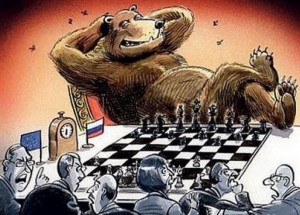by Adam Proveaux 
The last two years have been a low point in US-Russian relations, although recently the situation is looking brighter. Secretary of State John Kerry met with his Russian counterpart, Sergei Lavrov in Sochi on May 12 to discuss how cooperation between the two nations might be maintained. There are many areas in which Russia and America could meaningfully collaborate with each other, including in Syria, Iran, Yemen and Ukraine. Both Secretary Kerry and a Russian spokesman for the Kremlin stressed that open dialogue is essential and still possible.
There are many issues which have to be addressed, and one of them is the role which the Crimean peninsula plays in the Russian strategic calculus.
Russia has recently sent bombers and rockets capable of deploying nuclear weapons to both Crimea and the Russian enclave in Kaliningrad (a Russian region sandwiched between Lithuania and Poland). Should Ukraine and the West be worried about this geopolitical chess move? Is Russia simply posturing, or actually threatening to use nuclear weapons? Whatever their true intentions, the Russians have the advantage of ambiguity and unpredictability on their side.
In a recently released documentary, Russian President Vladimir Putin reflected that he had considered placing Russia’s nuclear forces on alert after the annexation of Crimea in March 2014. It is not clear if the Russians intend to place nuclear weapons in Crimea, although they seem to be leaving the option open. In December 2014, the commander of Russia’s Strategic Missile Forces said that Russia has no need to place nuclear weapons Crimea since Russia’s long-range ballistic missiles are already sufficient to reach any target in the world. In March 2015, however, a Russian Ministry of Foreign Affairs official for nonproliferation said:
“We regard Crimea as part of the Russian Federation. Of course, Russia has a right to deploy nuclear weapons in its territory if necessary, [but] I have no idea if any nuclear weapons are deployed there now and I am unaware of such plans but Russia can do it.”
Russia’s Motivation
The December 2014 statement is most telling. There is no military need to place nuclear weapons in the reclaimed territory, but the Russians appear to be trying to intimidate, nonetheless. Russia’s impetus is most likely one part bluster and one part a maneuver to counteract perceived NATO aggression.
In 2000, Putin signed a “National Security Concept” which listed NATO expansion as one of the major threats to Russia’s national security. There is still disagreement among policy experts as to whether the administration of George H.W. Bush promised Gorbachev that NATO would not expand into former Soviet satellites if the Russian leader acquiesced to the unification of Germany. Former U.S. Secretary of State James Baker has denied that any such agreement existed, but Jack Matlock, the U.S. ambassador to Moscow in 1990, insists that the United States did indeed make a commitment to Russia that NATO would not expand. Today, President Putin insists that NATO has broken its promises and has continually sought to marginalize Russia.
In December 2014 Russia alleged that NATO surveillance activities along Russia’s Baltic border had increased by a factor of seven. The chief of General staff of the Russian military said, “The intensity, the operational and combat readiness of the alliance’s troops is being increased near the Russian border. In these circumstances… we have to take retaliatory measures”.
In fact, NATO has significantly increased its planned exercises for 2015. More than six large-scale exercises are planned for the remainder of 2015 and will involve as many as 25,000 or more troops. One of these exercises is designed to ensure that NATO rapid-response forces are capable of assembling within forty-eight hours and is “an effort to show resolve and solidarity in the face of what the alliance brands Russian aggression in Ukraine. Recently there have been numerous reports of Russian encroachments into U.S. and European airspace and close fly-bys of NATO ships in the Black Sea.
In March, Russian news agency TASS reported that the Russian Foreign Ministry was concerned about the U.S. establishing an airbase in Estonia as part of upcoming join US-Estonian exercises. On April 10, Russia’s Deputy Foreign Minister declared that practice NATO nuclear missions nearly amount to violations of the Treaty on the Non-proliferation of Nuclear Weapons (NPT) and expressed continued opposition to NATO’s expansion toward Russia.
Now what?
The Russians have the reputation of being excellent chess players, and there is a particular chess move called “castling” which the Russians may be seeking to employ on a global stage. “Castling” occurs in chess when a player switches the places of a knight and rook- it is the only time that more than one piece can be moved during a turn.
Especially under Putin’s leadership, Russia has proven many times that its foreign policy decisions are based simultaneously on a long-term strategy of asserting Russian influence and an interest in seizing opportunities as they arise. Russia maintains an ambiguous policy which leads other nations to distrust or perhaps even fear it—which may be exactly the point. This is why the “castling” metaphor is so fitting. By placing launchers that could include nuclear weapons in Crimea, Russia has upped the ante of its rhetorical threats without giving away its true intentions or spending money for new weapons.
Russia already has the capacity to strike anywhere in Europe that it chooses, and so moving launchers does not in fact increase its nuclear capacity. On the other hand, the uncertainty sparked in the West by such actions may boost Putin’s Russian position at home even while undermining it abroad. But this is not a game changer. These bluffs only become dangerous if the West is fooled into brinkmanship.
image source: Source: Kaifolog.ru
